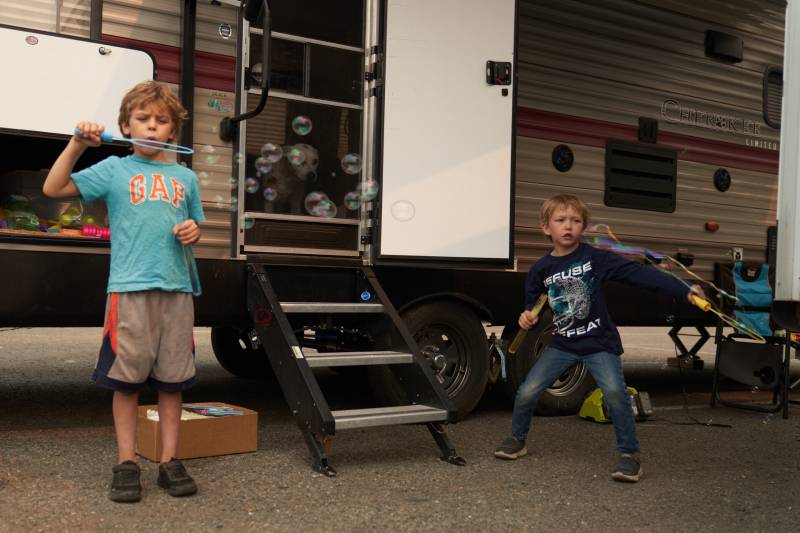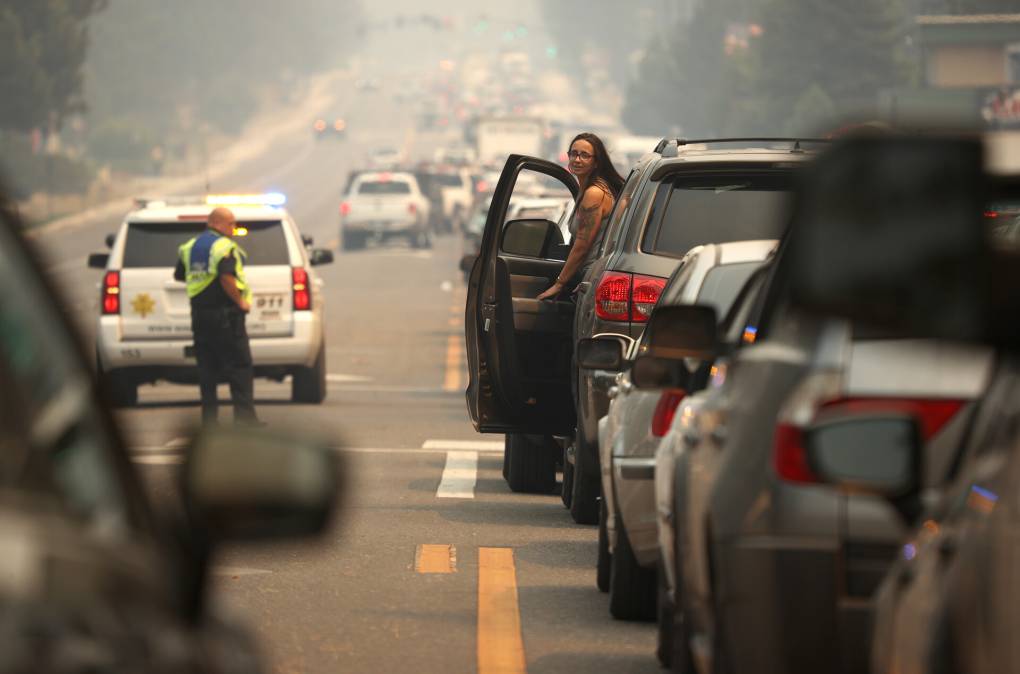On Sunday, the 22,000 residents of South Lake Tahoe were allowed to return to their homes a week after being ordered to evacuate as the Caldor Fire crossed the Sierra Nevada. And as fire crews continue working to contain the fire, more evacuation orders may be lifted in the region.
But even if a community is spared from a fire’s direct path, returning to one’s home after a wildfire can be tough — practically and emotionally.
“Some may not want to return because of the difficulty of seeing your home and possessions in ashes,” said wildfire survivor Rob Goodman, who lost his home in the 2015 Valley Fire in Lake County.
Once a fire has burned through an area, many dangers remain. Damage to buildings can make structures unstable, debris and downed trees can block roads and downed utility lines pose serious electrical and other hazards. Fire officials also warn that the risk of flooding remains high for weeks and months after a wildfire, due to the amount of destroyed vegetation that once stabilized the soil.
“If you do decide to return, I must urge great caution,” Goodman told KQED in 2017. “Your site will be toxic — containing everything from metals to plastics to wiring, plumbing, etcetera.”
Even for homes that are only partially damaged or even seemingly intact, there are numerous precautions residents should take when returning after evacuation orders are lifted — precautions that may not be immediately obvious.
So if you are a full-time South Lake Tahoe resident planning your return home — or if, like many others, you own property in the Tahoe region and want to check in on your cabin or holiday home — we have expert advice on what to keep in mind before, during and after your trip back.
On your way back home
Before heading out to your home or cabin, confirm that your destination is under an evacuation warning — not a mandatory order. Read more on the difference between an evacuation order and an evacuation warning.
Cal Fire Amador-El Dorado provides daily updates on their @CALFireAEU Twitter account and CAL Fire AEU Facebook page, about which areas are now under a warnings and which roads are operational. As of Monday, Highway 50 from the Nevada state line to the South Lake Tahoe city limits has reopened to traffic heading back to the city.
If you don’t live full-time in South Lake Tahoe and want to check on your property home, it’s important to remember just how delicate the repopulation process can be for a city or town, and to the people who call that place home. Same for if you don’t live in South Lake Tahoe and are wondering when you can visit again. Read how to help Caldor Fire evacuees, which includes staying away from Tahoe right now.
A day after the evacuation orders were lifted, Tamara Wallace, mayor of South Lake Tahoe, spoke with KQED about what was happening on the ground as folks returned.
“There’s limited services,” she said, sharing that as of Monday morning, only one grocery store had reopened. Wallace added that she was planning to hold off her own return for a few days so as not to take up scarce resources.
Both Wallace and Cal Fire recommend that residents currently allowed to return to their homes first stock up on groceries, gas and other essential supplies before making the trip back.
“Give us a minute to get our services back up and running and get people resettled,” said Wallace. “And then we welcome you back.”
If you’re worried that your home did not survive the fire, the El Dorado County Sheriff’s Office has created a searchable online map showing the status of every structure within the Caldor Fire that uses information from field damage inspections. These inspections are ongoing and the information shown is subject to change — so if you don’t see your property on the map, keep checking.
On Twitter, KQED’s Raquel Maria Dillon also compiled a list of available online resources and maps for keeping track of the status of roads and ski resorts.
Listeners @KQEDForum asked how tech can help with wildfires & evacs. At this point, people just want to know if their home/cabin/favorite ski run is OK. But that’s a slow process, where an official has to document each structure. Resources in thread: @KQEDnews #caldorfire 1/? https://t.co/TECnb2PpJm
— Raquel Mª Dillon (@RaquelMDillon) September 3, 2021
What if you evacuated South Lake Tahoe but don’t currently have access to a car to return to the city? Lake Tahoe Unified School District and the Tahoe Transportation District are providing free transportation services from the Reno evacuation shelter (located at 4590 South Virginia Street in Reno) back to the Stateline Transit Center to connect with existing Tahoe Transportation District routes to South Lake Tahoe.
Once you’ve arrived at your home
Disasters like wildfires and floods create additional safety hazards, often leaving behind toxic chemicals, gas leaks, broken glass, exposed rebar or nails and tripping hazards.
- Check for the smell of gas. Don’t enter if you smell gas, and call your utility company immediately.
- Inspect your home for hot embers or material that may still be burning — in gutters, attics, crawl spaces or even holes in the ground.
- Be aware of slippery floors or broken material that could stab or puncture you.
- If there is any visible damage to gas lines, propane tanks or electrical wiring and meters, DO NOT attempt to turn them on or repair them. Contact your local utility immediately.
- If the utilities look undamaged, turn off power until you’ve completed your inspection.
- When you’re ready to turn the power on, first turn off all appliances and make sure the meter is not damaged before turning on the main circuit breaker.
- Keep an eye out for sparks, broken wires, or cracks in the roof, foundation or chimney, as well as plumbing and sewage system damage, household chemical spills and damaged appliances.
- Do not drink water from the faucet until officials say it’s safe to drink. Water supply systems can be damaged or become polluted during disasters.
- Discard all food that’s been exposed to heat, smoke, fumes, soot or flood waters. If the power has been out, discard food that could be spoiling.
What to bring/wear when you return home
- Sturdy shoes and clothing
- Heavy-duty gloves
- Heavy-duty mask, like an N95
- Battery-powered radio to monitor for emergency updates, weather reports, flash flood warnings and news reports
- Battery-powered flashlight
- Stick or gardening implement to sift through ashes
- 5-gallon bucket for any possessions
Health and safety considerations
Public health officials recommend that you refrain from cleaning ash and fire debris, and instead let professional hazardous material removal services do so. The ash and debris can contain asbestos, heavy metals, fire retardants, pesticides and toxic airborne particles.
If you do return to a fire-damaged site that hasn’t been cleaned up yet, keep the following in mind:
- Pace yourself. Be aware of exhaustion. Stay hydrated.
- Wear protective gear if handling any fire-damaged items, sifting through ash or being exposed to soot. Sturdy shoes, clothing, work gloves and respirator masks like N95s are recommended.
- Wash your hands frequently.
- Keep children and pets away.
- Remember that large-scale movement of materials or removal of debris and ash should be coordinated with government agencies.
Looking ahead
If your home suffered damages or was entirely destroyed, your options depend on whether you’re the property owner or the tenant.


